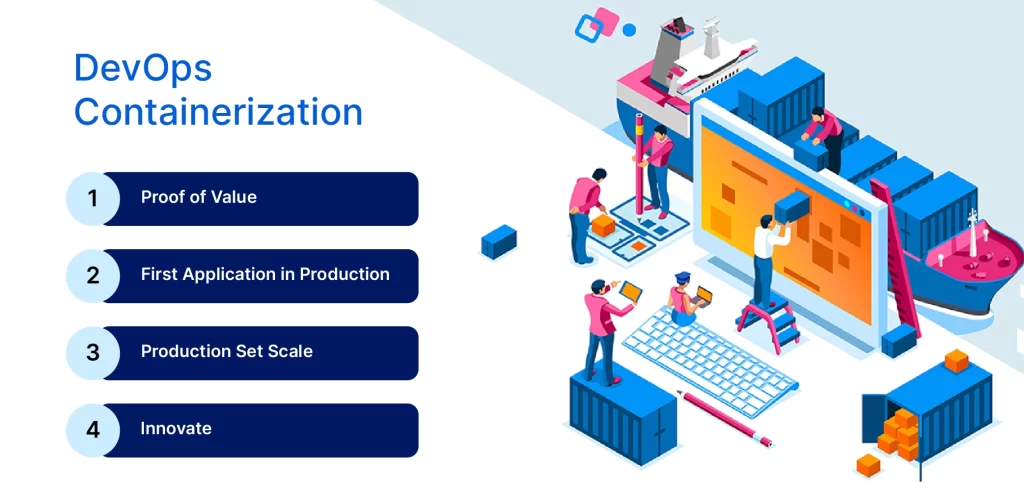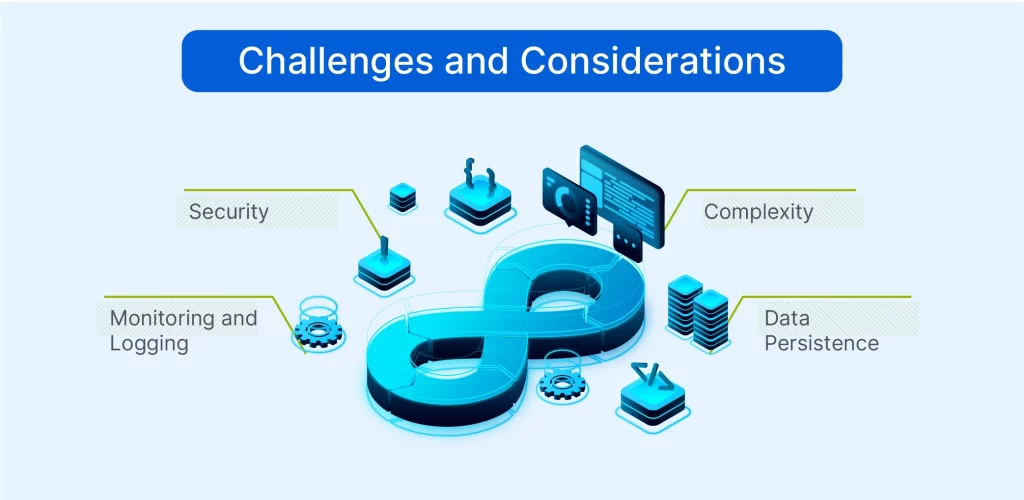When teams operate independently, it creates communication gaps that can lead to disorder. In contrast, when teams collaborate, they tend to be more efficient.
The terms development and operations are combined to produce the term “DevOps,” which refers to a cooperative or shared approach to the duties carried out by a company’s application development and IT operations teams.
In the fast-paced world of software development and operations (DevOps), containers have emerged as a transformative technology. They have revolutionized the way applications are developed, deployed, and managed. This ultimate guide will walk you through everything you need to know about containers in DevOps.
DevOps containers are pivotal components in modern software development and deployment practices. These containers act as self-contained environments that encapsulate applications, along with all their dependencies and configuration settings. Think of them as compact, portable units that can be easily moved and deployed across different computing environments. This approach streamlines the deployment process, enhances consistency, and reduces conflicts that can arise from differences in development and production environments. By leveraging containers DevOps, development teams can ensure smoother collaboration, quicker application delivery, and a more reliable software deployment pipeline.
A methodology called DevOps aims to enhance productivity throughout the whole software development lifecycle. Plan, code, build, test, release, deploy, operate, monitor, and — through feedback — plan, which resets the cycle, are the processes that make up a DevOps process.
DevOps services imply that an IT team creates software that fully satisfies user requirements, installs quickly, and performs well right away. To do this, organizations use a mix of culture and technology.
Developers and stakeholders discuss the project and collaborate on incremental upgrades that go live independently of one another in order to align software to expectations.
IT teams move code automatically from one stage of development and deployment to another using CI/CD pipelines and other automation techniques to reduce wait times. Teams can implement regulations to make sure that releases adhere to standards and instantly review changes.
At its core, a container is a lightweight, standalone, and executable software package that includes everything needed to run an application, including code, runtime, system tools, libraries, and settings. Containers provide a consistent and isolated environment, ensuring that an application runs reliably across different computing environments, from a developer’s laptop to production servers.
Unlike traditional virtual machines (VMs), which virtualize the entire operating system, containers virtualize at the application level. This means that containers share the host system’s operating system kernel, making them incredibly lightweight and efficient. Containers are also portable across various platforms, thanks to their isolation and standardized packaging.
In the world of DevOps, there are various kinds of containers that hold different apps. Think of them like boxes for software. Docker containers are like organized boxes that keep apps and their stuff separate from others. Then there’s Kubernetes, which is like a manager for many containers, making things run smoother. OpenShift is similar to Kubernetes, but it’s got extra features for bigger companies. Lastly, there’s Cloud Foundry, which lets developers put their apps out without worrying too much about the technical stuff. These containers are like a toolkit for DevOps, each with its way of helping out.
Every organization has its own difficulties that take too long, subpar software, and IT that restricts business expansion.
A DevOps project progresses more quickly from the specification to live software since there are no wait times, manual processes, or drawn-out reviews. Reduced cycle times can prevent requirements from changing, ensuring that the final product meets client expectations.
The “It worked on my machine” statement is not used by developers in a DevOps culture when a problem occurs.
DevOps containerization is comparable to neatly packaging your program together with all of its requirements. Everything your software needs to function properly is contained in this box, sometimes referred to as a container. It functions almost like a lunchbox for your apps, storing and organizing them. These containers are simple to move around and install on other systems. So, just as you would organize your digital possessions into virtual boxes, containerization aids in the efficiency and organization of things in the DevOps environment.

Containers encapsulate an application and its dependencies, ensuring that it behaves the same way across different environments. This consistency reduces “it works on my machine” issues and streamlines collaboration between development and operations teams.
Containers provide isolation between applications, preventing conflicts between different services running on the same host. This isolation enhances security and stability.
Containers share the host’s operating system kernel, which minimizes overhead compared to traditional VMs. This efficient use of resources allows for higher density and scalability.
Containers can be spun up or down quickly, enabling rapid application deployment and scaling to meet changing demands. This agility is essential in modern DevOps practices.
Since containers package everything an application needs to run, they can be easily moved between different environments, from development to testing to production.
Containers can be versioned and stored in container registries. This version control ensures that the right version of the application and its dependencies are deployed, eliminating compatibility issues.
Containers are the foundation of microservices architecture, allowing applications to be broken down into smaller, manageable services that can be developed and deployed independently.
Several containerization technologies have gained prominence, with Docker being the most well-known. Docker introduced a user-friendly way to create, deploy, and manage containers. It popularized the use of container images, which are read-only templates containing application code and its dependencies.
Another significant technology is Kubernetes, an open-source container orchestration platform. Kubernetes automates the deployment, scaling, and management of containerized applications. It allows for high availability, load balancing, and self-healing capabilities, making it a crucial tool for managing containers at scale.
Containers and DevOps are intertwined concepts that complement each other perfectly. DevOps emphasizes collaboration and automation between development and IT operations teams. Containers simplify the deployment and management of applications, providing a common environment for development and operations teams to work together seamlessly.
DevOps teams can use containers to build Continuous Integration/Continuous Deployment (CI/CD) pipelines, enabling automated testing, deployment, and monitoring. Containers also facilitate the practice of infrastructure as code (IaC), where infrastructure configurations are defined and managed using code, leading to more consistent and reproducible environments.
While containers offer numerous benefits, there are challenges to be aware of:

Containers share the host OS kernel, which can potentially lead to security vulnerabilities. Proper configuration and regular updates are essential to mitigate risks.
Managing a large number of containers and orchestrating their deployment can become complex. This is where tools like Kubernetes come into play.
Monitoring containerized applications requires specialized tools to track performance and troubleshoot issues effectively.
Containers are typically designed to be stateless, which can pose challenges when dealing with applications that require data persistence.
DevOps archives faster delivery without compromising quality because of containers. Create a containerized pilot system after conducting the necessary research and planning. Create and complete an enterprise-wide containerization plan, and roll it out gradually after successful completion. Continue to support and maintain. This should imply that the supply, deployment, and installation of the software are seamless and dependable.
Containers have revolutionized the world of DevOps by providing a consistent, portable, and efficient way to package and deploy applications. They foster collaboration between development and operations teams, streamline the software development lifecycle, and enable the rapid deployment of applications at scale. As the DevOps landscape continues to evolve, containers remain a foundational technology that empowers organizations to innovate faster and deliver reliable software solutions.
Follow IntellicoWorks for more insights!

Talk to us and let’s build something great together
A Subsidiary of Vaival Technologies, LLC
IntelliCoworks is a leading DevOps, SecOps and DataOps service provider and specializes in delivering tailored solutions using the latest technologies to serve various industries. Our DevOps engineers help companies with the endless process of securing both data and operations.
Ops
Cloud
AI & ML
Copyrights © 2023 byIntellicoworks. All rights reserved.